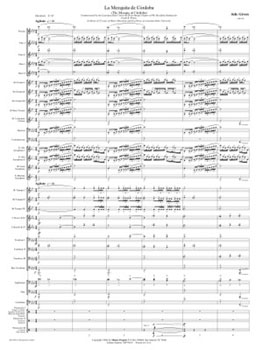Instrumentation
1 - Piccolo
4 - Flute 1
4 - Flute 2
1 - Oboe 1
1 - Oboe 2
4 - B♭ Clarinet 1
4 - B♭ Clarinet 2
4 - B♭ Clarinet 3
2 - B♭ Bass Clarinet
1 - E♭ Contrabass Clarinet
1 - B♭ Contrabass Clarinet
2 - Bassoon
1 - Contrabassoon
2 - E♭ Alto Saxophone 1
2 - E♭ Alto Saxophone 2
2 - B♭ Tenor Saxophone
1 - E♭ Baritone Saxophone
2 - F Horn 1& 3
2 - F Horn 2 & 4
3 - B♭ Trumpet 1
3 - B♭ Trumpet 2
3 - B♭ Trumpet 3
2 - Trombone 1
2 - Trombone 2
2 - Trombone 3
2 - Bass Trombone
2 - Euphonium B. C.
2 - Euphonium T. C.
4 - Tuba
1 - Contrabass
1 - Timpani & Bar Chimes
1 - Tubular Bells
2 - Marimba 1 & 2
3 - Finger Cymbals, Maracas, Triangle,
Jingle Stick, Egyptian Tambourine
2 - Castanets, Bodhran (Skin Drum)
3 - Suspended Cymbal, Ethnic (trash)
Suspended Cymbal, Crash Cymbals,
Bass Drum
La Mezquita de Córdoba (11:45)
The Mosque at Córdoba
Grade 5
by Julie Giroux
Commissioned by the Louisiana State University Beta Omega Chapter of Phi Mu Alpha Sinfonia for Frank B. Wickes
in honor of 25 years of music education
and excellence at Louisiana State University
Program Notes
In 169 B.C. the Romans founded Córdoba. After the fall of Rome, it existed under the rule of the Visigoths and became the capital of Al Andalus, Muslim Spain, in 716.
The Moors conquered Córdoba in the eighth century and by the tenth century the city boasted a population of 500,000, compared to about 38,000 in Paris. According to the chronicles of the day, the city had 700 mosques, some 60,000 palaces, and 70 libraries - one reportedly housing 500,000 manuscripts and employing a staff of researchers, illuminators and book binders. Córdoba also had some 900 public baths as well as Europe’s first street lights.
Reigning with wisdom and justice, the rulers of Córdoba treated Christians and Jews with tolerance. They also improved trade and agriculture, patronized the arts, made valuable contributions to science, and established Córdoba as the most sophisticated city in Europe.
When the Moors conquered Córdoba, they found a Visigoth cathedral, promptly pulled it down and built a mosque complex, the walls of which enclosed about four acres. It was over 40 years in the making. Over the centuries, the Moors roofed-over and developed more and more within this complex. Muslim, Christian, and Jewish faiths alike were practiced within its walls, an unprecedented feat then and literally unheard of today.
When the Christians reconquered Córdoba in 1236, the new rulers were so awed by its beauty that they left it standing, building their cathedral in the midst of its rows of arches and columns. Thus it is preserved today, fondly referred to in Spain as "La Gran Mezquita."
La Mezquita contains over 500 marble, granite, and alabaster columns. Mixed into the califal styles, one can see the Byzantine and oriental influences, as well as Hispano-romanic and Visigoth elements throughout the mosque. The grandeur of La Mezquita and its colorful political and religious history has earned it its place as a true wonder of the civilized world.
"La Mezquita de Córdoba" opens with the destruction of the original Christian church in 716 A.D. and proceeds as a musical celebration of its multi-cultural, religious and artistic accomplishments.
-J.G.


Home | Composers | Grade Levels | Order Form | Contact
©2010 Musica Propria, Inc.

